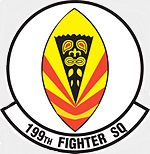Hobby Master HA1972 USAF McDonnell F-4D Phantom II Fighter-Bomber - "Aloha Alert," 199th Tactical Fighter Squadron "Fightning Tikis", 154th Tactical Fighter Group, Hawaii ANG (1:72 Scale)
"My fifth MiG kill was an exact duplicate of a syllabus mission (at Fighter Weapons School), so I had not only flown that as a student, but had taught it probably a dozen times prior to actually doing it in combat."
- Captain Richard "Steve" Richie commenting on his fifth and final aerial victory which occurred on August 28th, 1972
 The McDonnell Douglas F-4 Phantom II is a two-seat, twin-engined, all-weather, long-range supersonic fighter-bomber originally developed for the U.S. Navy by McDonnell Aircraft. Proving highly adaptable, it became a major part of the air wings of the U.S. Navy, Marine Corps, and U.S. Air Force. It was used extensively by all three of these services during the Vietnam War, serving as the principal air superiority fighter for both the Navy and Air Force, as well as being important in the ground-attack and reconnaissance roles by the close of U.S. involvement in the war.
The McDonnell Douglas F-4 Phantom II is a two-seat, twin-engined, all-weather, long-range supersonic fighter-bomber originally developed for the U.S. Navy by McDonnell Aircraft. Proving highly adaptable, it became a major part of the air wings of the U.S. Navy, Marine Corps, and U.S. Air Force. It was used extensively by all three of these services during the Vietnam War, serving as the principal air superiority fighter for both the Navy and Air Force, as well as being important in the ground-attack and reconnaissance roles by the close of U.S. involvement in the war.
First entering service in 1960, the Phantom continued to form a major part of U.S. military air power throughout the 1970s and 1980s, being gradually replaced by more modern aircraft such as the F-15 Eagle and F-16 Fighting Falcon in the U.S. Air Force and the F-14 Tomcat and F/A-18 Hornet in the U.S. Navy. It remained in service in the reconnaissance and Wild Weasel roles in the 1991 Gulf War, finally leaving service in 1996. The Phantom was also operated by the armed forces of 11 other nations. Israeli Phantoms saw extensive combat in several Arab-Israeli conflicts, while Iran used its large fleet of Phantoms in the Iran-Iraq War. Phantoms remain in front line service with seven countries, and in use as an unmanned target in the U.S. Air Force.
Phantom production ran from 1958 to 1981, with a total of 5,195 built. This extensive run makes it the second most-produced Western jet fighter, behind the famous F-86 Sabre at just under 10,000 examples.
The F-4 could carry up to 18,650 pounds (8,480 kg) of weapons on nine external hardpoints, including air-to-air and air-to-ground missiles, and unguided, guided, and nuclear bombs. Since the F-8 Crusader was to be used for close combat, the F-4 was designed, like other interceptors of the day, without an internal cannon. In a dogfight, the RIO or WSO (commonly called "backseater" or "pitter") assisted in spotting opposing fighters, visually as well as on radar. It became the primary fighter-bomber of both the Navy and Air Force by the end of the Vietnam War.
Due to its distinctive appearance and widespread service with United States military and its allies, the F-4 is one of the best-known icons of the Cold War. It served in the Vietnam War and Arab-Israeli conflicts, with American F-4 crews achieving 277 aerial victories in Southeast Asia and completing countless ground attack sorties.
Pictured here is a signed 1:72 scale diecast replica of a USAF McDonnell F-4D Phantom II fighter-bomber that was nicknamed "Aloha Alert," and attached to the 199th Tactical Fighter Squadron, 154th Tactical Fighter Group, Hawaii Air National Guard.
Sold Out!
Dimensions:
Wingspan: 6-1/4-inches
Length: 10-1/2-inches
Release Date: June 2016
 Historical Account: "Fighting Tikis" - The 199th Fighter Squadron (199 FS) is a unit of the Hawaii Air National Guard 154th Wing located at Joint Base Pearl Harbor-Hickam, Honolulu, Hawaii. The 199th is currently equipped with the F-22A Raptor.
Historical Account: "Fighting Tikis" - The 199th Fighter Squadron (199 FS) is a unit of the Hawaii Air National Guard 154th Wing located at Joint Base Pearl Harbor-Hickam, Honolulu, Hawaii. The 199th is currently equipped with the F-22A Raptor.
The wartime 463d Fighter Squadron was re-designated as the 199th Fighter Squadron, and was allotted to the Hawaii Air National Guard, on May 24th, 1946. It was organized at Bellows Field, Waimanalo, Hawaii, and was extended federal recognition on November 4th, 1946, by the National Guard Bureau. The 199th Fighter Squadron was bestowed the lineage, history, honors, and colors of the 463d Fighter Squadron. The squadron was equipped with F-47N Thunderbolts and was operationally gained by Seventh Air Force. Its mission was the air defense of Hawaii.
Bellows Field, which was attacked during the December 7th, 1941, Japanese attack on Oahu, was excess after World War II ended, and it served as home for the Hawaii Air National Guard.
In 1947, the costs to operate Bellows as an active Air National Guard station led the Territorial government to negotiate with the Army about its future. The Army indicated that it wanted to retain the field in a commissioned status but that it had no funds to maintain the field. The Army offered the Aviation Unit of the Hawaiian National Guard joint use of the field provided all maintenance was assumed by the Guard. A settlement was reached to move the 199th to Hickam Field, and to use excess facilities there.


